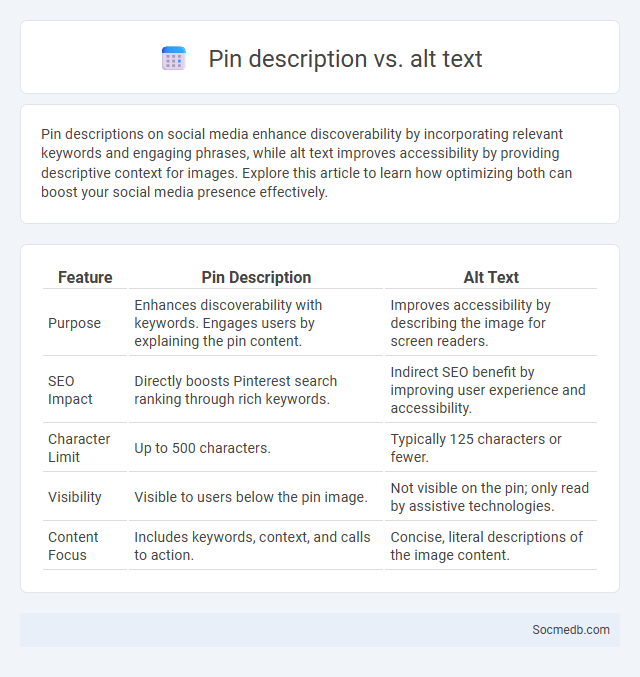
Photo illustration: pin description vs alt text
Pin descriptions on social media enhance discoverability by incorporating relevant keywords and engaging phrases, while alt text improves accessibility by providing descriptive context for images. Explore this article to learn how optimizing both can boost your social media presence effectively.
Table of Comparison
| Feature | Pin Description | Alt Text |
|---|---|---|
| Purpose | Enhances discoverability with keywords. Engages users by explaining the pin content. | Improves accessibility by describing the image for screen readers. |
| SEO Impact | Directly boosts Pinterest search ranking through rich keywords. | Indirect SEO benefit by improving user experience and accessibility. |
| Character Limit | Up to 500 characters. | Typically 125 characters or fewer. |
| Visibility | Visible to users below the pin image. | Not visible on the pin; only read by assistive technologies. |
| Content Focus | Includes keywords, context, and calls to action. | Concise, literal descriptions of the image content. |
Understanding Pin Description, Alt Text, and Their Differences
Pin descriptions on social media platforms like Pinterest provide clear, keyword-rich explanations that enhance searchability and user engagement. Alt text serves as an accessibility tool by describing images for visually impaired users while also improving SEO through relevant keywords. Understanding the differences helps You optimize content effectively, ensuring better visibility and inclusivity across your social profiles.
What Is a Pin Description on Pinterest?
A Pin description on Pinterest is a brief text that explains the content and purpose of your Pin, helping users understand what they will find when they click through. This description enhances searchability by including relevant keywords, increasing your Pin's visibility and engagement on the platform. You should craft clear, concise, and keyword-rich descriptions to maximize your Pin's reach and attract your target audience effectively.
Defining Alt Text: Its Purpose and Usage on Pinterest
Alt text on Pinterest serves as a crucial accessibility feature by providing descriptive information for images, enabling visually impaired users to understand visual content. It enhances search engine optimization by incorporating relevant keywords that improve discoverability within Pinterest's search results. To optimize your pins effectively, ensure your alt text is concise, descriptive, and includes targeted keywords related to your content.
How Pin Description and Alt Text Impact Pinterest SEO
Pin descriptions on Pinterest significantly enhance SEO by incorporating relevant keywords that improve visibility in search results and attract targeted audiences. Alt text serves not only as an accessibility tool but also boosts SEO by providing context to Pinterest's algorithm, helping pins rank higher for related queries. Utilizing both detailed pin descriptions and descriptive alt text increases engagement and drives more organic traffic to boards and websites linked to Pinterest content.
Best Practices for Writing Effective Pin Descriptions
Craft compelling Pin descriptions by using relevant keywords that match your target audience's search intent, boosting your content's visibility on Pinterest. Keep descriptions clear and concise, highlighting the benefits or features of the Pin to engage users effectively. You should include a strong call-to-action to encourage saves, clicks, or shares, driving more traffic to your website or profile.
Crafting Compelling Alt Text for Pinterest Accessibility
Ensuring Pinterest posts are accessible involves crafting compelling alt text that accurately describes images for visually impaired users. Effective alt text includes specific keywords related to the image content, enhancing SEO and discoverability within Pinterest's search algorithm. Clear, concise descriptions improve user engagement and support inclusive digital experiences across social media platforms.
Pin Description vs Alt Text: Key Differences Explained
Pin descriptions provide context and keywords to enhance discoverability on Pinterest, directly influencing search rankings and user engagement. Alt text is primarily designed for accessibility, describing images for users with visual impairments and improving SEO by helping search engines understand the content. While both improve content visibility, descriptions target audience interaction, whereas alt text ensures inclusive access and semantic clarity.
Why Both Pin Description and Alt Text Matter
Pin description and alt text are critical for enhancing Pinterest's search algorithm and improving content accessibility, respectively. Pin descriptions use targeted keywords to boost visibility in user searches, while alt text ensures visually impaired users can understand image content, increasing engagement from diverse audiences. Combining both elements optimizes SEO and user experience, leading to higher traffic and better brand reach.
Common Mistakes to Avoid with Pin Description and Alt Text
When crafting pin descriptions and alt text for social media, avoid keyword stuffing that makes content appear spammy and reduces engagement. Ensure your pin description clearly conveys the value or purpose while incorporating relevant keywords naturally to enhance discoverability. Your alt text must accurately describe the image content for accessibility, improving SEO and reaching a broader audience.
Optimization Tips: Maximizing Engagement with Pin Description and Alt Text
Optimizing your social media strategy involves crafting compelling Pin descriptions that include targeted keywords to boost visibility and drive engagement. Using clear, descriptive alt text not only improves accessibility but also enhances SEO by helping platforms understand the content of your images. By combining keyword-rich descriptions with thoughtful alt text, you significantly increase the chances that your Pins will reach your target audience and maximize interaction.
 socmedb.com
socmedb.com